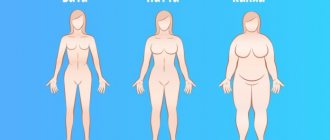In this article we will tell you:
- Causes of obesity
- Adipose tissue as an endocrine organ
- Obesity disorders
- Fatty liver
- Nutrition for obesity
- Prohibited Products
- Childhood obesity
- Nutrition Strategies for Children
- Diagnosis of obesity
- Pregnancy and obesity
Obesity
- one of the most common pathologies of the 21st century and a real scourge of modern society. This is a widespread problem in all countries - from highly developed ones (for example, in the UK, the percentage of overweight patients has long exceeded 20) to less industrialized ones. According to WHO estimates, in 2004 alone the number of obese people exceeded 1.4 billion - what can we say now, 12 years later?
This is not only a decisive factor and trigger for most cardiovascular diseases and metabolic disorders, but also a disease that significantly reduces the standard of living.
Causes of obesity
Genetics, of course, plays a significant role at all levels of the functioning of the body and makes a significant contribution, in particular, to the constitutional features of the structure. However, the final word remains with external factors and the conditions that surrounded the child from the cradle: after all, even the healthiest baby, with the wrong approach from parents, threatens not only to gain extra pounds and centimeters of subcutaneous folds, but also to develop persistent eating habits that are similar to those of an adult. age will invariably become an obstacle to the right lifestyle.
Among the main causes of excess weight are the following:
- Energy imbalance
- in other words, we consume more than we can spend.
Our body is an ingenious system, which in any situation - in the conditions of peaceful coexistence of all residents inhabiting it, both cellular and non-cellular in structure, or during civil wars in the form of autoimmune diseases, when foreign pathogenic agents invade its territory - takes care mainly about one goal: how to maintain balance - the key to normal functioning, first of all, of enzymes.
Most reactions occurring in the human body require energy. Glucose transport, ion transport, activation of signaling pathways - all require a kind of currency in the form of ATP molecules. So, it is simply unprofitable to eliminate all the excess substances that come with food through the intestines: you never know when that rainy day will come.
Thus, adipose tissue, at one time, ensured survival: our ancestors did not manage to kill mammoths and saber-toothed tigers every day.
- Hypothalamic disorder
- the main conductor of energy exchange. It is in this, one of the key structures of the brain, that the centers of “hunger” and “saturation” are located, and a number of protein and polypeptide molecules involved in the control of appetite are produced.
- Endocrine
- decreased thyroid function (hypothyroidism), decreased production of adrenal hormones and somatotropin by the adenohypophysis.
- Sleep disorders
: the synthesis of hormones responsible for hunger and satiety (ghrelin and leptin) is associated with the sleep-wake cycle.
- Long-term use of certain medications
- in particular, glucocorticoids.
What is obesity?
Obesity is a disease characterized by excessive fat deposition and, as a result, excessive development of adipose tissue. The main factor influencing weight gain is the discrepancy between the intake of calories into the human body and their expenditure. There are also other reasons for the occurrence of this dangerous disease, namely: endocrine disorders, hereditary constitutional predisposition, some physiological conditions (pregnancy, lactation, menopause), professional activity.
Today, over a billion people in the world are overweight and in one of the 4 stages of obesity. In Russia, 50% of women and 30% of men suffer from this, in Germany - every second resident, in Britain and North America - every third, in the USA - every fifth. Excess weight is determined quite simply and the Quetelet index is used for this. It is calculated by dividing a person's mass by the square of his height in meters (weight in kg/height in m2).
Weight is considered normal when the index is: for women – 19-24, for men – 20-25, an indicator above this indicates excess fat deposits. At stage I of obesity, the actual body weight exceeds the ideal by no more than 15-29%, at stage II - 30-49%, at stage III - 50-100%, at stage IV - more than 100%.
Adipose tissue as an endocrine organ
Adipose tissue
- a source of many biologically active substances and hormones that exhibit both central and peripheral effects.
First of all, leptin is produced here - a satiety hormone, which, freely passing through the customs border of the blood-brain barrier (using a special transport system) separating nervous tissue from the circulating blood, affects the receptors of the hypothalamus - a key structure of the brain, where it reduces the production of the hormone responsible for hunger neuropeptide Y. A feeling of satiety occurs.
Interestingly, the level of this hormone differs significantly between men and women - in the former it is significantly lower, which is associated with higher concentrations of testosterone in the blood.
An increase in the amount of adipose tissue is invariably accompanied by an increase in leptin production, which entails a natural decrease in the sensitivity of cellular receptors to it - leptin resistance develops.
Study
: Obesity
Such disorders affect not only appetite dysregulation: leptin is also involved in the functioning of the reproductive system. Thus, many researchers note the cyclical nature of leptin levels, which is associated with the sequential change of conductors in a woman’s body—sex hormones. In particular, its concentration reached a maximum in the luteal phase, when this protein hormone actively stimulated the programmed death of corpus luteum cells - their apoptosis - in the absence of pregnancy.
Study
: The hormone leptin and reproduction problems
Another equally important hormone produced by fat cells is adiponectin
- also has, like leptin, a protein nature. Activation of signaling pathways leads to:
- Increased glucose utilization by skeletal muscles.
- Relaxation of smooth muscles and, as a result, a decrease in blood pressure. This effect is mediated by stimulation of endothelial cells, the inner lining of blood vessels, to produce a relaxation factor - nitric oxide.
- Prevents the division and calcification of smooth myocytes of the vascular wall, thus providing an antiatherogenic effect. In addition, it suppresses the uptake of cholesterol and its esters by cleansing cells - macrophages - which, despite the wide range of enzymes they contain, are unable to break down this organic compound and only accumulate it, turning over time into so-called “foam” cells .
- Suppression of glucose synthesis from non-carbohydrate components - inhibition of gluconeogenesis in the liver.
Study
: Metabolic effects of adiponectin
For children
Nutritional (constitutional-exogenous) obesity in children is characterized by uniform accumulation of adipose tissue. This form occurs in 90% under the age of one year. With age, a slight degree of excess weight occurs. During puberty, girls gain even more weight. The number of fat cells in a child depends on the genetic factor, and the size of fat cells is already influenced by the nutritional factor. Excessive nutrition during the critical puberty period leads to an increase in their size.
The difficulties in organizing nutrition for children suffering from this pathology lie in the fact that, on the one hand, the child’s body must receive vitamins , macro- and microelements, and a sufficient amount of proteins. On the other hand, children who are prone to weight gain should be limited in their diet. This should happen through carbohydrates (mostly easily digestible) and fats.
You should offer buns, candies, cookies, jam and other sweets as rarely as possible. Potato dishes, pasta and dough dishes (dumplings, dumplings, pancakes, pancakes) should be included in the menu very rarely. Lamb, pork, beef fats and margarine should be excluded. Vegetables and unsweetened fruits should prevail in the diet.
Of course, it turns out that with such restrictions, nutrition becomes hypocaloric, and a decrease in calorie content causes the consumption of fat from the depot. In the early stages of the disease, metabolism is normalized more easily and quickly and weight is reduced. Typically, caloric intake is reduced by 200-600 kcal. You should not sharply limit or quickly reduce caloric intake. This can cause weakness in the child and headache .
The diet for obese children includes:
- Meals 6 times a day and in small portions. Breaks between meals of 2.5-3 hours suppress the feeling of hunger and reduce appetite, so the child will not eat a large amount of food at the next meal.
- Dinner is no later than 19:00 and should be light.
- High calorie foods should be given in the first half of the day. Breakfast and lunch can consist of meat and fish dishes, and dinner can consist of vegetable and dairy dishes.
- Eating slowly and chewing thoroughly. At the same time, the feeling of fullness comes faster, and the child will not overeat.
Children's dietary food should include the age-specific norm of protein obtained from cottage cheese, yogurt, meat, fish, kefir, and milk. Three-year-old children should eat 80 g of meat per day, preschoolers - 100 g, from 7-12 years old up to 150 g of meat. Cottage cheese should be present in the diet daily in an amount of 50-80 g. Dairy products in an amount of 400-600 ml.
Vegetable juices are useful because they are lower in calories: tomato, beet, carrot, cabbage or a mixture of juices. Soups should be cooked vegetarian, and once a week in weak meat broth. To diversify a child’s diet, steamed meatballs, cutlets, dumplings and meatballs are prepared from fish and meat.
Dietary meals for obese children and the technology for their preparation can be found in reference books on therapeutic nutrition. Of course, not many children like vegetables, but perhaps from the list of dishes you will be able to choose the most suitable for your child.
You can prepare vegetable stew, eggplant sauté, carrots with béchamel sauce, cabbage casserole, cabbage, carrot, beet or zucchini cutlets, cabbage schnitzel, boiled fish with zucchini and low-fat sour cream, fish cutlets with vegetable garnish, cottage cheese with herbs, omelette with green beans or zucchini (tomatoes). For dessert, you can offer cranberry or lemon jelly with xylitol.
Older children are prescribed fasting days once a week with a caloric food content of 600-800 kcal. These can be standard fasting diets: dairy, apple, cottage cheese, kefir. Treatment with hunger is contraindicated, since catabolic processes intensify in the child’s body, and this can inhibit growth and disrupt the maturation of the body.
The child’s physical activity is also an important therapeutic factor. Physical activity significantly increases metabolic rate and accelerates weight loss.
Obesity disorders
- Hypertonic disease
- is associated, first of all, with the direct stimulation of the sympathetic nervous system by insulin, the concentration of which in the blood is many times higher than normal in people with excess body weight (its mediators, as is known, interact with the corresponding receptors on myocardial cells, increase the frequency and strength of contractions, and also have a direct effect on smooth myocytes of the vascular wall).
In addition, insulin also affects the kidneys: it promotes the retention of sodium, which drags water along with it - the volume of circulating blood increases.
With obesity, the production of angiotensinogen by adipocytes also increases - its subsequent conversion to angiotensin 2 stimulates the adrenal cortex to secrete aldosterone, a mineralocorticoid, which causes reabsorption of sodium in the renal tubules and the secretion of potassium.
In addition to this, the right atrium reduces the synthesis and release of natriuretic hormone, which helps reduce the concentration of sodium in the blood by excreting it in the urine - edema develops.
Study
: Obesity‐Related Hypertension: Pathogenesis, Cardiovascular Risk, and Treatment
- When fat is deposited in the chest and abdominal area, the mobility of the diaphragm - the main respiratory muscle - and ribs is limited, which leads to violations of ventilation of the pulmonary parenchyma
. In such patients, there is a decrease in vital capacity of the lungs, as well as a decrease in forced expiratory volume.
In addition, obesity suppresses the synthesis of the pro-inflammatory hormone adiponectin, which increases the risk of bronchial asthma.
- Disorders of carbohydrate metabolism
- in particular, the development of insulin resistance - a decisive step in the pathogenesis of type 2 diabetes mellitus. So, say, in the liver, free fatty acids prevent insulin from binding to hepatocytes, and also suppress the inhibitory effect of this hormone on gluconeogenesis (the synthesis of glucose from non-carbohydrate components).
In addition, free fatty acids have a toxic effect on the insulin-producing beta cells of the pancreas and impair the uptake and further utilization of glucose by skeletal muscle.
Study
: Obesity and insulin resistance
Fatty liver
Non-alcoholic fatty liver disease
(NAFLD) is one of the most common diseases in gastroenterology, which is characterized by the overgrowth, in the literal sense of the word, of hepatocytes with fat cells - the liver turns into goose foie gras.
Fatty liver, as a rule, is associated with excess intake of carbohydrates into the body: when all the energy needs of the cells are satisfied, part of the excess will be wisely stored in the liver storerooms in the form of glycogen - an energy reserve for a “rainy day”. However, given the limited space allocated for storing jars of jam, what could not be transformed into glycogen will turn into lipids in the process of biochemical reactions.
So, you shouldn’t be afraid of fats in your diet: they gain weight precisely because of the uncontrolled intake of sugars, which initially seem healthy and harmless. “Everything is poison and everything is medicine,” Paracelsus correctly stated.
We recommend
“What is vitamin D for: a detailed review” Read more
Obesity activates a signaling pathway in hepatocytes that is invariably associated with chronic inflammation and increased levels of lipid metabolites such as diacylglycerol. The latter, by preventing phosphorylation of the insulin receptor, directly contributes to the development of insulin resistance.
In addition, an increase in the concentration of free fatty acids contributes to the disruption of their oxidation in our power plants - mitochondria - and leads to an increase in the production of free radicals located in them. Oxidative stress develops, which further damages the organ parenchyma and stimulates the progression of fibrosis - the replacement of liver cells with connective tissue.
In most patients, NAFLD does not manifest clinical symptoms, or they are not specific enough:
- dull pain in the right hypochondrium;
- fatigue;
- dyspepsia;
- hepatosplenomegaly - an increase in the size of the liver and spleen.
Laboratory indicators also do not always reflect the picture: for example, the levels of ALT and AST (alanine aminotransferase and aspartate aminotransferase) may be slightly elevated or even remain within normal limits - which is why it is undesirable to rely solely on their concentration when making a diagnosis.
It is much more effective to assess uric acid (more than 20% of overweight individuals have hyperuricemia), C-reactive protein, and serum ferritin concentrations, both of which are characteristic and highly sensitive markers of inflammation and are elevated in fatty liver disease. In addition, insulin, glucose and C-peptide levels, as well as the lipid profile, must be monitored.
Study
: Non-alcoholic fatty liver disease and obesity: Biochemical, metabolic and clinical presentations
Nutrition for obesity
Obese patients, in addition to moderate physical activity, need to create the right diet in tandem with a nutritionist that satisfies all the necessary needs of the body. First of all, the main rule for them can be formulated as follows: spend more than you receive.
Strict calorie restriction is a direct road to breakdown and subsequent depressive states and self-flagellation. Yes, reducing your calorie intake makes sense - but only in cases where it is adequate and gradual.
In general, in the absence of adrenal fatigue, three meals a day remains a universal diet for most people. Maintaining “hungry” intervals by eliminating all snacks between main meals helps to establish carbohydrate metabolism and increase the sensitivity of cell receptors to insulin.
In addition, it is advisable to adhere to intermittent fasting - its simplest variation, which you need to start with, is 12/12 - in other words, within 12 hours you eat (2 or 3 meals are ideal), in the remaining 12 ( including sleep) - drink exclusively water, herbal teas or coffee without milk or sugar.
Over time, you can “lengthen” the fasting window and move on, for example, to practicing 14/10, 16/8 and 20/4 - any of these techniques is an effective way to carefully, smoothly lose weight, and then maintain its normal level.
Also, patients with excess body weight should exclude fast carbohydrates - sweets, dried fruits, honey, which contribute to a rapid increase in glucose levels and an equally sharp decline. Considering that in the mechanisms of development of insulin resistance, one of the key roles belongs to fructose, which sophisticatedly bypasses all saturation pathways, strict control over fruit consumption and their limitation are mandatory.
It is recommended to consume at least 30 grams of fiber - this is not only a powerful stimulator of intestinal motility, but also a kind of broom that cleanses its lumen. You can use psyllium powder or apple pectin as a source, washing them down with water or adding them (as a binder) to the dough. However, given that dietary fiber also acts as a sorbent, it must be taken separately from other dietary supplements.
Authorized Products
- Lean fish, mussels, shrimp, squid and other low-calorie seafood, which are prepared by boiling or baking.
- Lean meat (beef, rabbit, chicken and turkey) is prepared in the same way.
- Cereals - brown rice, buckwheat, basmati rice, oatmeal. Porridge is boiled in water and the serving is 2 times smaller than usual. The frequency of porridge consumption decreases with grades 2 and 3 of the disease.
- Vegetable soups, cabbage soup, borscht, cooked in water, vegetable broth or secondary meat broth.
- Legumes with a low glycemic index can be included in the diet several times a week: green beans, soybeans, green and red lentils. Mature legumes should be limited.
- Egg whites.
- Grain bread and yeast-free bread with bran.
- Cashews and peanuts, which have a GI of 15, can sometimes be enjoyed as an addition to salads.
- Vegetables and fruits in general 500 g per day. In addition to fruits, you can eat dried apricots and prunes, which have a GI of 40, bran, sesame and flax seeds as a source of fiber.
- Preferred vegetables include: green peas, all types of onions, cucumber, kohlrabi, eggplant, all types of cabbage, broccoli, Brussels sprouts, Chinese cabbage, cucumbers, celery, seaweed, zucchini, green salads, radishes, radishes, turnips, sorrel ( of uric acid is elevated ), vegetable tops, chard, dill, sweet peppers, parsley, mushrooms, chicory, spinach, garlic. Boiled carrots, potatoes and pumpkin have a high glycemic index and should be excluded. But you can eat raw carrots and beets.
- Low-fat cottage cheese and dairy products, this also applies to hard cheeses. To dress salads, you can use natural yogurt using 2 tablespoons. Its calorie content is several times lower than the same amount of vegetable oil.
- To dress salads, you need to use unrefined vegetable oils (olive, sesame or flaxseed, corn), but in the amount of 1 tbsp. l. Per day, given the very high calorie content.
- Weak tea with fructose, herbal teas, green tea, table water, rosehip infusion, vegetable juices with lower calorie content and unsweetened fruit juices (orange, pomegranate, apple).
Table of permitted products
| Proteins, g | Fats, g | Carbohydrates, g | Calories, kcal | |
Vegetables and greens | ||||
| greenery | 2,6 | 0,4 | 5,2 | 36 |
| eggplant | 1,2 | 0,1 | 4,5 | 24 |
| zucchini | 0,6 | 0,3 | 4,6 | 24 |
| cabbage | 1,8 | 0,1 | 4,7 | 27 |
| broccoli | 3,0 | 0,4 | 5,2 | 28 |
| boiled cauliflower | 1,8 | 0,3 | 4,0 | 29 |
| bulb onions | 1,4 | 0,0 | 10,4 | 41 |
| carrot | 1,3 | 0,1 | 6,9 | 32 |
| cucumbers | 0,8 | 0,1 | 2,8 | 15 |
| salad pepper | 1,3 | 0,0 | 5,3 | 27 |
| radish | 1,2 | 0,1 | 3,4 | 19 |
| white radish | 1,4 | 0,0 | 4,1 | 21 |
| red radish | 1,2 | 0,1 | 3,4 | 20 |
| black radish | 1,9 | 0,2 | 6,7 | 35 |
| salad | 1,2 | 0,3 | 1,3 | 12 |
| beet | 1,5 | 0,1 | 8,8 | 40 |
| soybeans | 34,9 | 17,3 | 17,3 | 381 |
| asparagus | 1,9 | 0,1 | 3,1 | 20 |
| tomatoes | 0,6 | 0,2 | 4,2 | 20 |
| Jerusalem artichoke | 2,1 | 0,1 | 12,8 | 61 |
| pumpkin | 1,3 | 0,3 | 7,7 | 28 |
| garlic | 6,5 | 0,5 | 29,9 | 143 |
| lentils | 24,0 | 1,5 | 42,7 | 284 |
| sorrel | 1,5 | 0,3 | 2,9 | 19 |
Fruits | ||||
| avocado | 2,0 | 20,0 | 7,4 | 208 |
| oranges | 0,9 | 0,2 | 8,1 | 36 |
| pomegranate | 0,9 | 0,0 | 13,9 | 52 |
| grapefruit | 0,7 | 0,2 | 6,5 | 29 |
| pears | 0,4 | 0,3 | 10,9 | 42 |
| kiwi | 1,0 | 0,6 | 10,3 | 48 |
| lemons | 0,9 | 0,1 | 3,0 | 16 |
| mango | 0,5 | 0,3 | 11,5 | 67 |
| tangerines | 0,8 | 0,2 | 7,5 | 33 |
| nectarine | 0,9 | 0,2 | 11,8 | 48 |
| peaches | 0,9 | 0,1 | 11,3 | 46 |
| apples | 0,4 | 0,4 | 9,8 | 47 |
Berries | ||||
| gooseberry | 0,7 | 0,2 | 12,0 | 43 |
| Red currants | 0,6 | 0,2 | 7,7 | 43 |
| black currant | 1,0 | 0,4 | 7,3 | 44 |
Mushrooms | ||||
| mushrooms | 3,5 | 2,0 | 2,5 | 30 |
Nuts and dried fruits | ||||
| sesame | 19,4 | 48,7 | 12,2 | 565 |
| flax seeds | 18,3 | 42,2 | 28,9 | 534 |
| fenugreek seeds | 23,0 | 6,4 | 58,3 | 323 |
Cereals and porridges | ||||
| buckwheat (kernel) | 12,6 | 3,3 | 62,1 | 313 |
| oat groats | 12,3 | 6,1 | 59,5 | 342 |
| cereals | 11,9 | 7,2 | 69,3 | 366 |
| millet cereal | 11,5 | 3,3 | 69,3 | 348 |
Dairy | ||||
| skim milk | 2,0 | 0,1 | 4,8 | 31 |
| natural yogurt 2% | 4,3 | 2,0 | 6,2 | 60 |
Cheeses and cottage cheese | ||||
| cottage cheese 0.6% (low fat) | 18,0 | 0,6 | 1,8 | 88 |
| curd tofu | 8,1 | 4,2 | 0,6 | 73 |
Meat products | ||||
| beef | 18,9 | 19,4 | 0,0 | 187 |
| rabbit | 21,0 | 8,0 | 0,0 | 156 |
Bird | ||||
| chicken fillet | 23,1 | 1,2 | 0,0 | 110 |
| turkey | 19,2 | 0,7 | 0,0 | 84 |
Fish and seafood | ||||
| fish | 18,5 | 4,9 | 0,0 | 136 |
| squid | 21,2 | 2,8 | 2,0 | 122 |
| mussels | 9,1 | 1,5 | 0,0 | 50 |
| seaweed | 0,8 | 5,1 | 0,0 | 49 |
Oils and fats | ||||
| linseed oil | 0,0 | 99,8 | 0,0 | 898 |
| olive oil | 0,0 | 99,8 | 0,0 | 898 |
| sunflower oil | 0,0 | 99,9 | 0,0 | 899 |
Non-alcoholic drinks | ||||
| green tea | 0,0 | 0,0 | 0,0 | — |
| * data is per 100 g of product | ||||
Prohibited Products
If you are overweight, it is strictly necessary to limit your intake.
:
- candies, ice cream, marshmallows, marmalade and other sources of refined sugars;
- sweet fruits
: mango, banana, persimmon;
- freshly squeezed juices and smoothies
- this is a real sugar bomb under the guise of a healthy lifestyle product;
- ready-made sauces
: they are not only sources of glutamates that excite the nervous system, but also extra calories and hidden sugar;
- fast food and semi-finished products;
- bakery products, instant cereals;
- dairy products
: they increase plasma levels of insulin and insulin-like factor-1, and also help increase the production of androgens;
- carbonated and alcoholic drinks.
Advantages and disadvantages
Like any therapeutic food, “Table 8” has positive and negative sides:
- Pros: a balanced diet gives a person a feeling of fullness, despite the low calorie content of foods. Abundant consumption of fiber with dietary fiber of plant origin promotes good digestion and normalizes metabolism in the human body.
- Cons: since carbohydrates stimulate the production of serotonin (“the hormone of joy”), their insufficient consumption often causes loss of energy, irritability, pessimism and a negative attitude towards life in patients.
Recommended cereals include:
- buckwheat;
- pearl barley;
- Brown rice;
- barley
Semolina, oatmeal or white rice should be added to the diet with caution.
Do not overuse potatoes and legumes. For dietary nutrition, it is recommended to eat low-fat meat:
- birds;
- young beef;
- rabbit meat.
From seafood you should choose the following types of fish:
- bream;
- zander;
- whiting;
- cod;
- carp.
It is recommended to boil, stew or bake meat and fish. The best processing method is steaming. It is recommended to eat eggs boiled and in omelettes with water or low-fat milk. Fried foods should be completely excluded from your diet. The norm for dishes containing animal fats is no more than 150 g per day.
Diet table nutrition rules 8.
It is recommended to limit the consumption of cheeses, including them in the menu no more than 1-2 times a week. Low-fat cottage cheese with a fat mass of up to 1.5%, an omelet from 2 eggs are allowed for consumption. You will have to give up sweet curds and yoghurts.
It is also advisable to limit the consumption of bread.
Small portions of baked goods made from wholemeal flour with added bran are allowed. The consumption of baked goods and baked goods made from wheat flour is strictly prohibited. It is advisable to completely exclude the consumption of sweet berries and fruits from the diet:
- grapes;
- pears;
- strawberries;
- cherries;
- bananas
It is recommended to eat sweet and sour fruits raw:
- oranges;
- lemons;
- grapefruits;
- apples;
- kiwi;
- pineapples;
- lime
Recommended drinks on the Table 8 diet:
- unsweetened tea with milk;
- compotes and fruit drinks without sugar;
- still mineral water without salt;
- fresh fruit and vegetable juices.
The main taboo applies to foods that stimulate the appetite, such as sweet and high-calorie desserts, spicy seasonings, smoked foods, marinades and pickles. Alcoholic drinks, cocoa, sweet tea and coffee, milkshakes, soda and lemonade are strictly prohibited.
List of prohibited products.
Childhood obesity
Childhood obesity
- one of the most pressing problems of the modern world - is the result of long-term energy imbalance, when the amount of energy consumed many times exceeds the body's needs.
Despite the certain role of genetics, the increase in the number of children suffering from obesity is associated primarily with low levels of physical activity and the predominance of junk food rich in sugars and trans fats in the diet.
Neuroendocrine disorders, congenital anomalies and chromosomal mutations fade into the background - their role in gaining excess body weight against the background of the influence of environmental factors is becoming more and more insignificant.
So, in the UK only in 2008, according to statistics, 16.8% of boys and 15.2% of girls aged 2 to 15 years had problems with excess body weight - one can imagine how these figures have changed now, 12 years later.
Obesity is associated with the development of insulin resistance, impaired glucose tolerance, and increased blood pressure, all of which contribute directly or indirectly to the development of chronic diseases. Similar to the adult body, in the child’s body the following are also noted:
- sleep apnea;
- cardiovascular pathologies;
- osteoarthritis;
- hypertension;
- depression, low self-esteem and deterioration in quality of life.
Study
: Obesity in children
Sample menu for the week
Despite the fact that many foods are excluded from the diet, the diet does not lose its diversity. For convenience, you can prepare a table in advance with an approximate daily diet. Menu option for every day:
| Day of the week | Breakfast #1 | Breakfast No. 2 | Dinner | Afternoon snack | Dinner |
| Monday | Boiled hake + boiled potatoes + cabbage salad + coffee without sugar | Low-fat kefir | Potato soup + boiled chicken + fresh cucumber + uzvar | Apple + rosehip decoction | Soft-boiled egg + piece of boiled beef with green peas |
| Tuesday | Fish cutlets + boiled egg + coffee | Kefir | Vegetable soup with barley + beef stroganoff with beets + sauerkraut salad + uzvar | Apple/berries | Boiled beef + boiled egg + tea with milk |
| Wednesday | Jellied fish + 2 boiled eggs | Apples + kefir | Vegetable soup + meat and vegetable stew + uzvar | Apple | Carrot-apple puree + cottage cheese + yogurt |
| Thursday | Boiled beef + kefir | Egg + apple + coffee | Lenten borscht + beef stroganoff + boiled potatoes + uzvar | Apple | Boiled chicken + green peas |
| Friday | A piece of boiled meat + kefir | Carrot soufflé + apple + coffee | Lenten cabbage soup + boiled hake + boiled potatoes + uzvar | Apple | Any boiled meat + tea with milk |
| Saturday | Steamed cheesecakes + coffee | Baked apple | Vegetarian borscht + baked rabbit with vegetables + cabbage salad | Curdled milk + bread | Fish soup + tomato salad + vegetable juice |
| Sunday | Cottage cheese + vinaigrette + tea | Apple | Lenten borscht + boiled meat + stewed cabbage + uzvar | Cottage cheese + milk | Kefir + a piece of rye bread |
There can be many menu examples for the week.
The main thing is to monitor the amount of food you eat and prepare dishes only in those ways that are allowed. Before going to bed, it is useful to drink low-fat kefir or yogurt.
Nutrition Strategies for Children
| Age | Calories | Fluid intake |
| 1 year | 900 kcal/day | 1100-1200 ml/day |
| 2-3 years | 1000 kcal/day | 1300 ml/day |
| 4-8 years | 1200 kcal/day for girls 1400 kcal/day for boys | 1600 ml/day |
| 9-13 years | 1600 kcal/day for girls 1800 kcal/day for boys | 1900 ml/day for girls 2100 ml/day for boys |
| 14-18 years old | 1800 kcal/day for girls 2200 kcal/day for boys | 2000 ml/day for girls; 2600 ml/day for boys |
| Age | Number of fruits | Number of vegetables |
| 1 year | 1 cup per day (250 ml) | ¾ cup per day |
| 2-3 years | 1 cup | 1 cup |
| 4-8 years | 1.5 cups | 1 cup for girls; 1.5 cups for boys; |
| 9-13 years | 1.5 cups | 2 cups for girls; 2.5 cups for boys; |
| 14-18 years old | 1.5 cups for girls; 2 cups for boys; | 2.5 cups for girls; 3 cups for boys; |
TUESDAY
Breakfast: sweet pilaf with dried fruits and nuts
Lunch: beetroot soup; meatballs with buckwheat (1-2 pieces will be enough)
Afternoon snack: salad with carrots and oranges
Dinner: salmon with lemon in paper + vegetables of your choice
Nutritionist's comment:Sweet pilaf with dried fruits is a nutritious and healthy dish for the first half of the day, containing carbohydrates, fats and dietary fiber. However, I would not recommend using it for dinner for weight loss. |
Diagnosis of obesity
Obesity
- one of the main components that make up metabolic syndrome. This is a whole complex of pathologies, which includes:
- insulin resistance;
- diabetes mellitus type 2;
- arterial hypertension;
- tendency to thrombosis;
- dyslipidemia;
- visceral obesity.
We recommend
“Microelements in the body: consumption standards and methods of replenishing the deficiency” Read more
According to WHO criteria for 2002, the following laboratory parameters are taken into account when making a diagnosis:
| BMI | over 30 |
| Fasting plasma glucose | more than 6.1 mmol/l |
| Triglyceride levels | more than 1.7 mmol/l |
| HDL content | for men - less than 0.9 mmol/l; for women - less than 1 mmol/l. |
| Waist-hip ratio (visceral obesity indicator) | For men > 0.9 For women > 0.85 |
| Arterial pressure | ≥140/90 mmHg |
Study
: Diagnostic criteria for metabolic syndrome
Pregnancy and obesity
Pregnancy
- a unique period in the life of every woman, which is characterized by a number of quantitative and qualitative changes aimed at creating the most favorable conditions for the growth and development of a new organism.
There is an intensive development of fatty tissue - that metabolic safety cushion that will provide the fetus with the necessary substrates for energy. We have already talked about the hormonal function of this tissue: here, due to the fairly high activity of the aromatase enzyme, androgens are transformed into estrogens - primarily into estradiol, thus mediating the extraovarian synthesis of sex hormones.
However, excess body weight is accompanied not only by a more enhanced function of the previously mentioned enzyme: changes also occur in the composition of estrogens themselves - in particular, the number of their active forms exceeds inactive ones. To this should be added the direct production of estrogen by the placenta - thus, the arithmetic summation reflects the development of hyperestrogenemia.
During the gestation period, the production of progesterone, a direct competitor of glucocorticoids for receptors in fat cells, also increases; by binding to them, it makes it impossible for adrenal hormones to activate lipolysis, the process of burning fat.
Starting from the 6th week, placental trophoblasts actively synthesize leptin, which stimulates hematopoiesis in the fetus and is involved in the regulation of growth and development processes. So, pregnancy is characterized by a whole orchestra of hormonal changes, however, a positive energy balance still plays a decisive role in the mechanisms of obesity.
There are specific recommendations regarding weight gain during pregnancy developed by the Institute of Medicine of the American Academy of Sciences and based on baseline body mass index. We remind you that BMI = weight (kg) : height² (m²)
| BMI before pregnancy | Body weight gain throughout pregnancy (kg) | Body weight gain per week (kg) |
| Low body weight (BMI < 20) | 12.5-18 | 0.5 |
| Normal body weight (BMI = 20-25) | 11.5-16 | 0.4 |
| Excess body weight (BMI= 25-30) | 7-11.5 | 0.3 |
| Obesity (BMI > 30) | < 7 | 0.2 |
Complications associated with excess weight
, during gestation are observed in 85% of patients and are accompanied by:
- Cardiovascular pathologies.
- Disorders of carbohydrate metabolism - physiological insulin resistance normally develops, in which the sensitivity of peripheral tissues to this pancreatic protein hormone is slightly reduced, which is necessary, first of all, to provide the developing fetus with energy.
Visceral obesity, in itself, is accompanied by excessive concentrations of insulin in the blood. Hyperinsulinemia occurs due to a compensatory increase in the production of the hormone by the islets of Langerhans in response to a decrease in the sensitivity of cellular receptors to it, and, therefore, the inability of glucose to properly enter the cells from the bloodstream. The risk of gestational diabetes increases from 2% (as it is in patients with normal carbohydrate metabolism) to 17% - more than 8 times.
All this cannot but affect the child’s health - the nature of the pathologies varies widely depending on the period at which hyperglycemia developed in the mother. Thus, it is noted:
- defects of the central nervous system;
- pancreatic cell hyperplasia;
- heart and gastrointestinal defects;
- intrauterine fetal death.
Newborns born to obese mothers most often have an increased risk of macrosomia, characterized by a body weight of more than 4000 g. These babies also tend to have higher levels of leptin and the pro-inflammatory interleukin-6.
In addition to all of the above, obesity is an independent risk factor for miscarriage and miscarriage, observed in conditions of excessive concentrations of androgens and insulin.
Study
: Pregnancy and obesity, Obesity and pregnancy: mechanisms of short term and long term adverse consequences for mother and child
General rules
Obesity is defined as excess accumulation of fat resulting from consuming calories that exceed a person's energy expenditure. High intake of carbohydrates and fats plays an important role in its development. The main criterion for diagnosing this condition is the body mass index, which, if it is from 25 to 40 kg/m2, is regarded as obesity of 1-2 degrees, and if it is more than 40 kg/m2, then obesity of extreme 4 degrees occurs. This is already a disease or so-called morbid obesity .
It is accompanied by neurohumoral and metabolic disorders, as well as changes in organ function. The problem is important because many diseases are associated with obesity: metabolic syndrome , diabetes mellitus , hypertension , dyslipidemia , osteoarthritis , sleep apnea and polycystic ovary syndrome . Even a slight excess of weight (just 10%) already leads to an increase in mortality by 20%, increasing the risk of cardiovascular disease and diabetes. Thus, it can be considered as a socially significant disease.
Treating this disease is a difficult task and first of all you need to find out the cause. The formation of excess weight is often associated with eating disorders, which are psychological in nature. For example, in patients suffering from bulimia nervosa. Bulimia is a psychosomatic disorder that manifests itself in uncontrolled food consumption. The second name for this disorder is ravenous hunger. Attacks of overeating are provoked by external influences and the disease can occur in the form of:
- paroxysmal absorption of food as a result of a strong appetite;
- constant consumption of large amounts of food;
- night food, when attacks occur at night.
Most often, the patient tries to get rid of the food he has eaten by vomiting or using enemas and laxatives. Bulimia with addiction to high-carbohydrate foods can occur with depression . In women, during the luteal phase, taste preferences change (a craving for sweets appears), appetite increases and transient bulimia .
Patients in whom decreased satiety is accompanied by anxiety-depressive disorders and bulimia are prescribed antidepressants . Therapy with appetite regulators ( Sibutramine , Dietressa ) is also effective.
A diet for obesity is always prescribed regardless of the cause that caused it. It is based on the principles of a balanced diet - it contains a sufficient amount of protein, vitamins and microelements. At the same time, the diet limits the amount of fat (from animals), salt (up to 3-5 g), easily digestible carbohydrates and free liquid (this depends on the degree of obesity), on average 1-1.2 liters. Any foods that stimulate the appetite are also limited.
It uses low-calorie foods: lean fish, seafood, dietary meat, low-fat cottage cheese, milk, eggs, which contain essential amino acids and vitamins . Non-digestible fiber and complex carbohydrates are represented by vegetables, fruits, cereals and grains. The patient obtains unsaturated fatty acids through the consumption of vegetable oils.
Proper distribution of calories throughout the day is important. This is due to the fact that in the first half of the day fat breakdown processes predominate, and after 18 hours liposynthesis accelerates (especially at night). Taking this into account, breakfast should be the most high-calorie, so it can include complex and simple carbohydrates and protein. Lunch is less high in calories. For dinner, which should be very light, you can eat lean meat/fish with a vegetable side dish. Or cottage cheese with kefir. After dinner you can only drink water or kefir.
The composition of foods, as well as proteins, fats and carbohydrates, varies depending on the degree of obesity, but the basic principles of nutrition are similar:
- Inclusion of vegetables and fruits - sources of fiber and complex carbohydrates. You need to consume them daily, spreading them over all meals, since fiber slows down the absorption of carbohydrates and fats and the process of converting carbohydrates into fats. They also inhibit the rise in post-meal glucose and the spike in insulin that promotes fat storage.
- Mandatory consumption of complex carbohydrates (whole grain bread, muesli, cereals, cereals).
- Introduce protein through lean meats, fish, eggs and dairy products.
- Healthy fats in the diet are represented by vegetable oils.
- Exclusion of simple carbohydrates (sugar, honey, baked goods, etc.). The need for sweets must be met with berries and fruits.
- Avoiding alcohol, flavor enhancers, and processed foods. Nuts, popcorn, seeds and chips, which are often used for snacking, are quite high in calories. These unaccounted calories take a toll on your weight. When visiting during feasts, you need to choose less calorie dishes.
- Proper cooking (stewing, boiling, baking). Any fried foods are excluded.
- The last meal is no later than 2 hours before going to bed.
Diet therapy also provides for the correct diet and the implementation of certain rules:
- Five (or more) meals a day. Fractional meals in small portions, including snacks, prevent the development of a strong feeling of hunger and prevent breakdown and withdrawal from the diet. Patients often have a perverted diet - they eat rarely, consume little food in the morning, and large portions late in the evening. Large meals increase the volume of the stomach and enhance the absorption of carbohydrates and fats.
- Correct distribution of calories: for breakfast - 30% of daily calories, for lunch - up to 40%, dinner - 10%, 10% is also allocated for snacks.
- Mandatory drinking regimen, if there are no contraindications - 1.5-2 l/day.
- Avoid eating “on the go” - chips, pies, sandwiches, crackers.
- For all degrees of obesity, a subcalorie diet is prescribed (contains significantly fewer calories than the diet of a healthy person). The degree of calorie restriction depends on the degree of obesity and the patient's condition.
For 1st degree obesity
Stage 1 obesity is characterized by a body mass index from 30.0 to 34. Patients at this stage do not consider themselves sick, they have no complaints from other organs, but sometimes they may experience weakness and increased fatigue. However, already at this stage you need to start fighting extra pounds, otherwise hyperinsulinemia , hypo ovarian function and menstrual irregularities may develop.
Simple carbohydrates and sugar should be eliminated completely, replacing them with sweeteners. The norm for bread consumption is 150 g. The daily calorie content is no more than 1500 kcal. Reducing calories to this level allows you to lose 8% of weight in six months. For moderate obesity, even reducing it by 500 kcal compared to normal calorie content is sufficient.
Excluded:
- sweet and puff pastries;
- fatty fish, caviar and canned food;
- fatty meats and sausages;
- salted and pickled vegetables;
- full-fat milk, sour cream, cream, full-fat cottage cheese;
- pasta.
With 2 degrees of obesity, the weight is 30-40% higher than normal and the BMI is 35-39.9.
The diet of patients at these two stages is similar. It is based on complex carbohydrates that have a low GI: whole grains, many vegetables and fruits. All of these foods are rich in dietary fiber. Vegetables or fruits should be included in the diet five times a day. You should eat fish at least twice a week. It must be remembered that fasting is contraindicated as it can lead to depression . As prescribed by your doctor, you may be prescribed a diet with a lower calorie content for a short time, which will be discussed below.
With grade 3 obesity, the BMI exceeds 40. With grade 3, there is already a pronounced weight gain, which causes psychophysical discomfort in the patient, leads to the appearance of concomitant diseases (musculoskeletal, cardiovascular systems) and sexual disorders. The patient’s well-being worsens, there is constant shortness of breath , pain in the heart area, weakness, and decreased performance. Complications of impaired metabolism are diabetes mellitus , pancreatitis , hypertension , and kidney stones .
The diet involves large calorie restrictions. Reducing calories is achieved by cutting down “fast” carbohydrates and fats. The daily diet consists of up to 80 g of protein, 60 g of fat and 100 g of carbohydrates. Daily calorie content is no more than 1300 kilocalories. Sometimes it is recommended to reduce it to 1000 kcal or more - 650-850 kcal. These are the so-called reduced diets. Such nutrition can be prescribed for a short time (maximum 3 months), and the patient himself must be under the supervision of a doctor.
It is unacceptable to use (even occasionally):
- confectionery, sweets;
- any sweet drinks;
- ice cream;
- sweet fruits (bananas, grapes) and dried fruits;
- sugar, honey, baked goods (sugar is replaced with xylitol , sorbitol , sweetener );
- foods that increase appetite (spicy sauces, smoked foods and seasonings).
It is better to exclude starchy vegetables from the diet completely. These include: potatoes, rutabaga, carrots, corn, pumpkin, Jerusalem artichoke, beets, mature beans and peas, squash, zucchini, parsnip and parsley root, radish, radish. However, this can be difficult to do in everyday life, so you need to use them as rarely as possible. Of course, potatoes, as the most highly starchy vegetable, are completely excluded from the diet.
The rate of fluid intake varies from person to person, usually no more than 1-1.2 liters per day. Salt intake is also significantly limited (3 g per day). In this regard, pickles and canned foods are contraindicated. The consumption of white bread, pasta, sago, white rice, and semolina is significantly limited.
The food menu may contain:
- vegetables: green peas, all types of onions, cucumber, kohlrabi, eggplant, all types of cabbage, broccoli, Brussels sprouts, Chinese cabbage, cucumbers, celery, seaweed, green salads, sorrel (rarely if uric acid levels are elevated), tops vegetables, chard, dill, sweet peppers, parsley, mushrooms, chicory, spinach, garlic;
- dietary varieties of bread (bran, grain, coarse);
- buckwheat and oatmeal, added to soup;
- unripe legumes (green beans, green peas);
- pears, apples, citrus fruits, kiwi, pineapples, plums.
When creating a diet menu for grade 3 obesity, you need to take into account not only prohibited foods, but also not exceed the volume of single servings and the number of foods allowed per day:
- fermented milk drinks 300 ml;
- low-fat cottage cheese 100 g;
- butter 5-10 g;
- one egg;
- fruit 200 g;
- allowed vegetables 200-300 g.
| Breakfast |
|
| Lunch |
|
| Dinner |
|
| Afternoon snack |
|
| Dinner |
|
| For the night |
|
At the same time, it is recommended to arrange fasting days - kefir, apple, vegetable, cottage cheese.
The diet ensures slow weight loss. You shouldn't try to lose weight quickly. The diet must be followed under the supervision of a specialist, and drug correction of metabolism and an effect on increased appetite are possible. Physical activity is required, the level of which will also be determined by a specialist taking into account concomitant pathology, but all patients, without exception, are recommended to walk for 45 minutes daily.
Obesity and diabetes are highly related. The risk of diabetes mellitus with third degree obesity will increase 10 times. If a person leads a sedentary lifestyle and consumes mainly carbohydrate foods, more insulin . The pancreas works overtime, which over time depletes it and leads to the development of diabetes.
Carrot, beet and tomato juice, without preservatives and additives, and celery juice are considered healthy
Nutrition for obesity and diabetes is based on significant restriction of carbohydrates. This also applies to sweet fruits. The permissible amount depends on the degree of carbohydrate metabolism disorder. If you have diabetes, choose fruits with a low glycemic index (GI less than 55 is considered low). Such fruits include: grapefruits, lingonberries, cherry plums, apples, apricots, cranberries, plums, cherries, peaches, sea buckthorn, currants, gooseberries. The permissible daily intake of these fruits is 200 g.
Patients should maintain a healthy intestinal microflora, since the quality of digestion and the absorption of substances depend on this. The quality of microflora improves with a sufficient amount of fiber and consumption of fermented foods (sauerkraut and other pickled vegetables, beet kvass, kombucha, pickled fruits).










